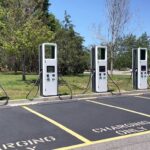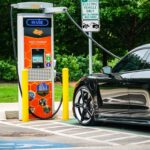Posts in the 'Energy + Climate Change' category
This is the third installment in a series of articles documenting lessons learned across NDC-TIA country activities, to be published throughout 2022. In Vietnam, a country home to 97 million inhabitants, there are 65 million registered motorcycles and mopeds,1.5 million ...

Urban freight and delivery services boomed during the COVID-19 pandemic as consumers switched to online shopping when businesses were forced to close. The surge in online market activity that began in 2020 builds on a decade of steady growth related to the ...

Electric buses are key to decarbonizing cities. Compared to internal combustion engine buses and cars, they improve air quality, reduce greenhouse gas emissions, are cheaper to operate and are more reliable in many cases. But the transition to electric buses ...

Cities have never been more engaged on climate action. At the 2021 UN Climate Change Conference (COP26), more than 1,100 cities representing a quarter of global CO2 emissions signed up to the Cities Race to Zero. In doing so, they committed ...

Vehicle ownership per capita has grown five‐fold in India since 2000. As a result, passenger transport activity has more than tripled, and energy demand more than doubled from 2000 to 2020. The transport sector is the third largest greenhouse gas ...

Editor’s Note: This article was updated in September 2022 to present new findings from WRI’s dataset tracking electric school bus adoption in the United States, covering April to June 2022. To the best of our knowledge, these statistics are up to date as ...

As hubs of talent and innovation, American cities are uniquely positioned to fight climate change and improve the health, economy and well-being of their residents. The Biden administration’s Justice40 Initiative and funding available through the Infrastructure Investment and Jobs Act (IIJA) provide rare ...

President Biden suggested that the United States implement a Federal Gas Tax holiday to help consumers weather historically high gas prices. Gas prices doubled in the United States between February 2021 and June 2022, topping out at more than $5 ...

Electric school buses are experiencing rapid growth in the United States, with a nearly 10-fold increase in commitments by school districts and fleet operators in the past year. Thirty-eight states have now committed to procure more than 12,000 electric school buses. In ...

Cities are increasingly trying to discern what post-pandemic resilience will look like, especially in terms of mobility and public transport. And in Colombia, cities are known for their innovations in public transport systems — like Bogotá’s bus rapid transport and ...

As our colleagues have covered previously, there are clear health and environmental benefits to adopting electric school buses instead of their diesel counterparts, which account for more than 90% of the U.S. school bus fleet and result in harmful exhaust ...

Electric vehicles (EVs) are on the rise in the United States. The Biden administration aims for 50% of new light-duty vehicle sales to be zero-emission by 2030. Some states have even more ambitious targets, like California, Massachusetts and New York, which plan to reach 100% new ...

America’s clean energy appetite continues to grow, with more than 180 U.S. cities committed to 100% renewable electricity. While this is promising, more needs to be done to expand the full benefits of clean energy to everyone in these communities. Historically, whiter, ...

As the latest IPCC report notes, cities will play a critical role in climate action over the next decade, and many challenges and opportunities for generating more clean electricity lie ahead. After remaining undaunted in their pursuit of renewables in 2020, U.S. ...

The latest findings from the IPCC paint a grim picture: Despite some signs of progress, the world’s chance of holding global warming to 1.5 degrees C (2.7 degrees F) is shrinking — and with it, our ability to prevent the most dangerous ...

Page 3 of 39« First...234...1020...Last »






















